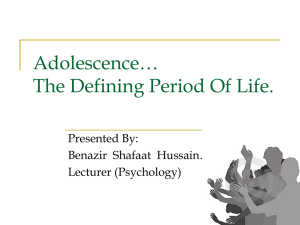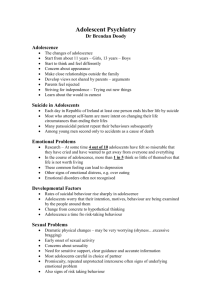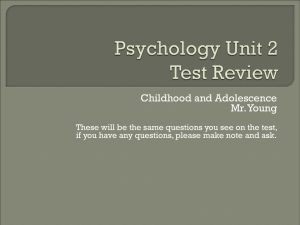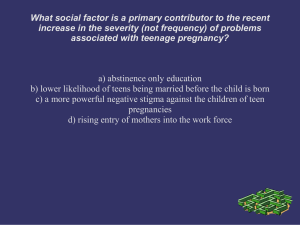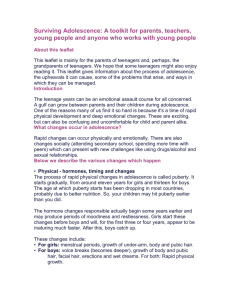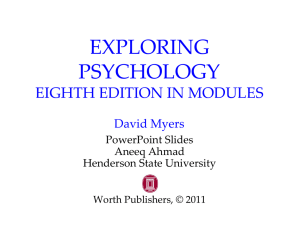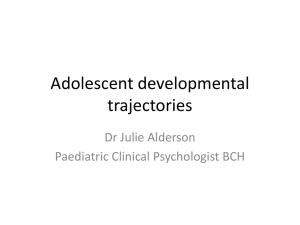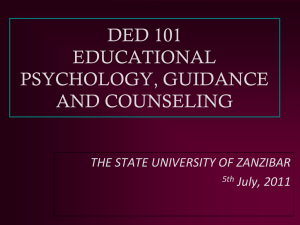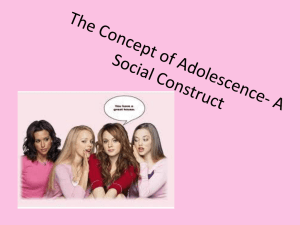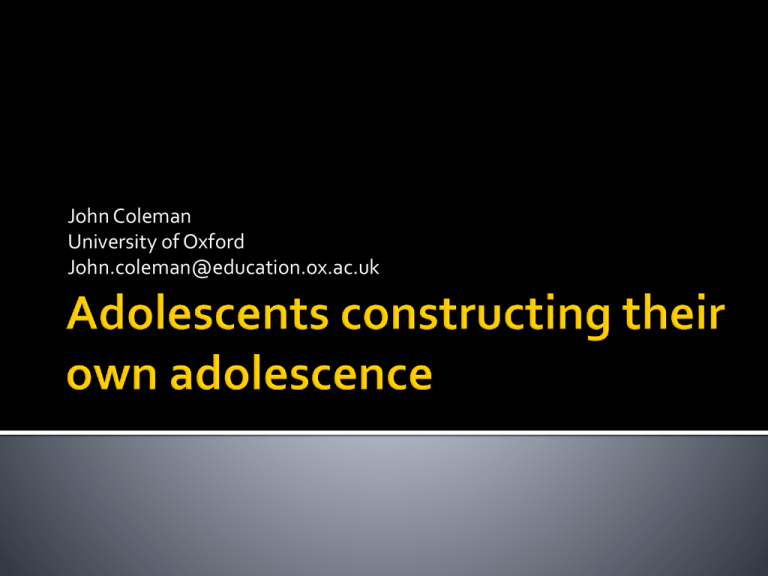
John Coleman
University of Oxford
John.coleman@education.ox.ac.uk
“They went through this list – what are the main
reasons for under-age people to have sex, and
they went through this list that they had made,
and it was all peer pressure, and to fit in, and stuff
like that, and they didn’t once mention that
people might just want to do it. They seemed to
think that no-one does things because they want
to, everyone does it to fit in. And most of the time
they don’t, you know, that hardly ever happens”.
17 year-old boy.
“Too often adolescents are portrayed as
passive recipients of circumstances ......
In reality they play an active role in
shaping the context in which they
operate”
(Feldman and Elliott, 1990)
This lecture is based on the fourth edition of
my book “The nature of adolescence” (2010),
and on the ideas contained within it.
The major objective of the book is to
highlight key areas of research that help us to
better understand adolescent development
Today I am going to take three areas of
research which I believe reflect what might be
called a new research agenda
It is not that the focus of these studies is
completely new, but rather that they
highlight new ways of thinking about
adolescence
I believe they all point towards a model that
engages with agency
I believe they are also important because
they show up a serious mis-match between
the findings of research and the models being
used in every day life.
An example of a mis-match between what a
parent believes and how a young person acts
The central point I want to explore today is
this mis-match, and its implications
I am arguing that adults are engaged in
creating a structure of authority and power,
whilst in reality young people are shaping
their own environment, constructing their
own adolescence!
“The teachers sometimes, they don’t really listen
to students. Things like with the school, they
just tend to do it. They put out a survey, and
then they just do the opposite of what we say.
Throughout the year they’ve done things like
that. They ask, but then they do the opposite
of what we say. I can’t really be bothered with
getting involved!” 15 year-old boy.
“I think like, with your parents, like, you can’t
really put your say in what you want. And they
won’t let you have your say in some things, but
like now at school you sort of get to have your
say in more things, like in lessons, and you can
say what you like, and in school council and
stuff”. 14 year-old girl.
I want to suggest, perhaps provocatively, that
we can envisage two models of interaction
between adults and young people.
One that is based on notions of agency, and
therefore on a bi-directional model, which
could be called a collaborative model
One based on a one-way view of
relationships, which would be called an
imperialist model.
One important feature of the book is that I
have tried to listen to young people talking
These young people made me think
differently
The interviews were carried out with a
random selection of adolescents
I want to show that the voices of young
people are important in this exploration of
our models of adolescence.
“I think you have to sort of stop going to people and
asking their opinions. You just have to think:
“what do I actually want to do, and what would it
turn out like if that did happen?” You need to
isolate yourself from them, because you can get
easily influenced by what your friends are saying
or what your parents are saying, and sometimes it
can’t really be right for you. You might not even
consider either of their views ......” 16 year-old
girl.
I believe that models of childhood from
earlier periods of history are still with us.
The Victorian notion of the child as a
possession, and the power balance that is
implied
The child or young person as an innocent,
needing protection
The parent as responsible for their children
These models imply a one-way relationship,
and are still very influential.
The life course model embraces the idea of
agency, thus very different from earlier models
The model is common to the sociology of youth,
and to developmental psychology
The life course is embedded in context, history,
time and place
Each stage affects other stages
Transitions and timing are critical
Individuals actively construct their “biography”,
thus the notion of human agency.
In sociology a good example of the way
agency can be described is work on what is
called “navigation”.
Models of navigation and life management
Here the young person is seen as navigating
his or her way through the transitions from
education to work, from home to
independent living and so on (Furlong, 2009).
But, how can agency be defined?
“In the social sciences agency refers to the
capacity of the individual to act
independently and to make their own free
choices. By contrast structure refers to those
factors which seem to limit or influence the
opportunities that individuals have.
Disagreement on the extent of one’s agency
often causes conflict between parties: e.g.
parents and children”.
The idea of agency has been around for a
long time in psychology
There is overlap with locus of control, and
with notions of self-efficacy
Early work in the 1960s and 1970s looked at
“child effects” in family relationships (Bell,
1968, Lytton, 1990)
As I shall show, much of the recent research
has been looking at “adolescent effects”
The focal model was described in Coleman
(1974). It was based on a large-scale study
It tackled the issue of how young people cope
with major change
It suggested that they are active agents,
managing the pace of change, and selecting
which issues to deal with on a day-to-day
basis.
Other research has supported the focal
model
But there is still a long way to go before
agency becomes integral to our model of
adolescence
The quotes given at the beginning made me
start to think about agency again
And this has coincided with some important
research on parents and teenagers
It was believed for many years that low
monitoring and supervision was linked to
higher levels of anti-social behaviour
(Graham and Bowling, 1995)
Many parenting interventions were based on
these ideas, ideas that were essentially unidirectional.
Along came Stattin and Kerr (2000). They
asked why there were low levels of
monitoring and supervision.
Stattin and Kerr’s (2000) research involved a
longitudinal study
It looked at young people aged 10 and 14
It identified key elements of relationships,
including disclosure and trust
It showed that children’s low level of
disclosure and poor communication at 10 was
related to low levels of monitoring and
supervision at 14.
Critical implications of Stattin and Kerr’s
research are that relationships are bidirectional
That parents modify their behaviour
depending on the behaviour of their sons and
daughters
That young people are agents and are active
in shaping the behaviour of their parents, just
as much as it works the other way round.
Parent behaviour
Young person’s
behaviour
New research on information management
has been developing, taking this idea
forward.
This research has looked at adolescents’
active role in strategically managing their
parents’ access to information
Marshall et al (2005) have shown that young
people are sophisticated in making decisions
about what to disclose.
Information management can be classified into:
telling all, telling if asked, omitting details,
keeping secret, and lying
The young person develops a complex set of
categorisations which helps him or her to decide
what to share with parents
This includes views about jurisdiction,
embarrassment, protection, privacy etc.
Importantly levels of non-disclosure increase
with age, whilst levels of secrecy remain
constant.
Judith Smetana has worked for ten years on
the interface between parents and teenagers,
and how agency is managed in the home
She shows that gradually adolescents take
more control of their lives, even though
parents want to hold back or continue to
exercise control
She calls her work “How teens construct their
worlds”.
“Adolescents’ appeals to personal jurisdiction
serve an important function in social
development. Parents’ claims to social
conventions, adolescents’ rejections of those
claims, and their appeals to personal
jurisdiction form an ongoing dialectic which
leads to transformations in the boundaries of
parental authority.” (Smetana, 2010)
“They think their room is their own, that they can
keep it that way if they want. But they’re wrong.
The room is part of the house. As long as they live
here, they have to follow my rules”.
“It’s my room, and it’s how I do things. In my room
I’m comfortable when it’s messy. It’s my space. I
know my parents would like it to be neat and tidy
like the rest of the house, which I can appreciate,
but my room is my own. It’s my space so I should
keep it the way I want.”
Clearly not everyone has the same degree of
agency
Social capital, environment, economic
factors, and cultural factors will all influence
agency
But, maybe two senses of agency?
Personal agency to do with major life choices
Personal agency to do with everyday
decisions and relationships
Low level of
agency
Medium level
High level of
agency
First, clearly the growth of agency is
developmental, as Smetana shows
Second, maybe parents and other adults
(teachers for example) hold back agency
because of fears about what young people will
do with too much freedom
Also, is this an elitist argument? Agency only for
the better off?
What about those who have little choice in life,
those who are victims of abuse for example?
The notion of personal agency is so important
because the model we hold of the child or
adolescent affects all we do:
It affects the way we think
It affects the way we interact in our
professional practice
It affects the way we do research.
I am suggesting two possible models of how we
conceptualise young people:
the imperialist model
the collaborative model
I am going to look briefly at two more
interviews, and then conclude by considering
how notions of agency might affect professional
practice.
“Well, I’m all for equal rights. I’m always going on
at my parents, sort of saying we’ve got equal
rights to them, and they’ve got no right to tell us
what to do. OK we are under 16, but .... We get a
lot of say in our house, it’s really democratic, and I
really hate it when my parents say “Do this”, and
you’ve got to do it, and you’ve got no say. You’re
like a robot doing things that other people tell you.
We’ve often talked about it, and it’s definitely
wrong, but then there’s got to be a limit.” 15 yearold girl.
“I think it’s a time when you go through a lot of
pressure, and there’s a constant battle within
yourself, and you have so many pressures from
outside, pressures from school, and parents and
friends, and you have to battle with all these, and
from that you have to say: “whatever all these are
saying, I have to think: what do I want to do?”
You want to do what you think is right, even if it is
wrong, you know that it’s what you chose to do,
so whatever happens it’s your fault. I’d rather
that, in some cases do something and if it’s wrong
I know it’s me, I chose to do it.” 16 year old girl.
There are good examples of models of
practice that have been shaped by ideas of
agency
In education the ideas behind “pupil voice”
represents one good example
Another, from health, involves the training of
vulnerable young people as health advocates
In social work, ideas about victimhood and
developing new identities also draws on
concepts of agency.
It is important to be aware of the models of
adolescence that underlie our work and our
relationships
A model which accepts agency would be a bidirectional model, a collaborative model
But, this is not how most adults operate!
Research over the last decade very much
endorses this model
If we engage with it, it will have profound
effects on our parenting and on our practice.
Bell, R (1968) A reinterpretation of the direction of effects in
studies of socialization. Psychological Review. 75. 81-95.
Coleman, J (1974) Relationships in adolescence. Routledge
and Kegan Paul.
Coleman, J (2010) The nature of adolescence: 4th Edn.
Routledge.
Feldman, S and Elliott, G (1990)(Eds.) At the threshold: the
developing adolescent. Harvard University Press.
Furlong, A (2009)(Ed.) Handbook of youth and young
adulthood. Routledge International.
Graham, J and Bowling, B (1995) Young people and crime.
Home Office Research Study No. 145. HMSO
Laird, R and Marrero, M (2010) Information management
and behaviour problems. Journal of Adolescence. 33. 297308.
Lytton, H (1990) Child and parent effects in boys’ conduct
disorder. Developmental Psychology. 26. 683-697.
Marshall, S et al. (2005) Information management:
considering adolescents’ regulation of parental
knowledge. Journal of Adolescence. 28. 633-648.
Smetana, J et al. (2010) Adolescents, families and social
development: how teens construct their worlds. WileyBlackwell.
Stattin, H and Kerr, M (2000) Parental monitoring: a
reinterpretation. Child Development. 71. 1070-1083


